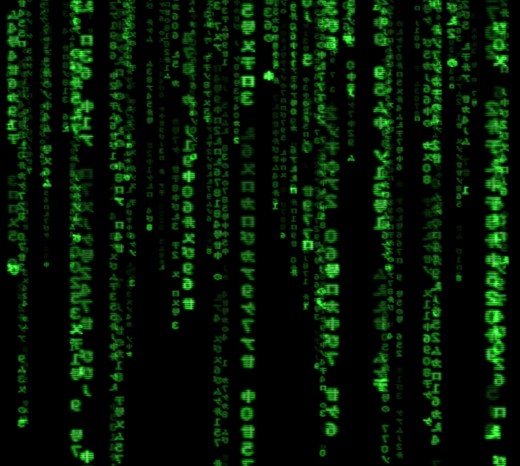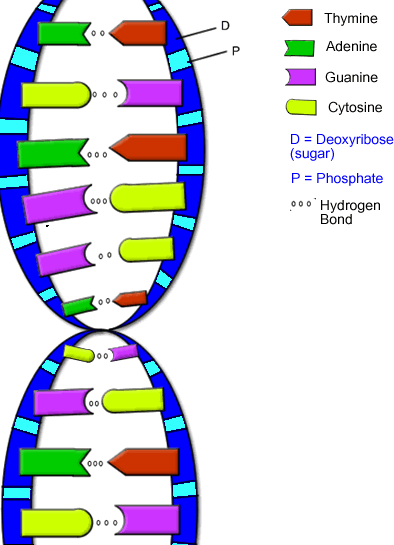Information Theory as applied to DNA: Intelligent Design.
The Matrix: Is it real? What is real?

What is Information?
The words you are reading right now, is not information. They are characters arranged in an agreed upon sequence, which conveys a message. The message itself, is the information.
The reason we can recognize information, is because we are sentient beings. We have cognitive function. We think, therefore we are. A "mind" (Whatever that means) is capable of recognizing information, because a "mind" is capable of producing information. Therefore, information can only be the product of a mind.
A very well done, and short, YouTube video explains this concept rather well.
What is Information? By MAYA(R) .
Structure in Living Organisms.

What is DNA?
When I speak of "DNA", I mean the whole polymer chain which every living organism known to us, has. Every strand of DNA has a carbon-copy of RNA, using the exact same materials. All DNA of every living organism has 4 basic combinations of polymers which is used in pairs in the double-helix structure of DNA. But because of the way in which these four polymer chains can bond, only two can pair together, but not with the other two polymers present in DNA.
The scientists who discovered this pairing rule had the privilege of having it named after them, which is the Watson-Crick "base pairing" rule. It goes as such: A always goes with T, and C always goes with G. Vice versa; T goes with A, and G goes with C. So the actual physical arrangement of these polymers along the double-helix, allow all four letters to be used in sequences. However, A or T never gets paired with G or C, because of the physical structure of these polymers! The chemical bonding capabilities of A only allow it to bond with T, and G can only bond with C.
Because of this physical bonding "rule" already built into the structure of DNA, it then becomes apparent that DNA is actually information.
Breaking it down! (Warning: Some math in the text that follows...)
Since there are only 4 types of nucleotides in DNA (guanine, adenine, thymine, and cytosine), it then can be represented by any 4 characters. Since they didn't know what to label them, they basically just gave them the values of the first letter of each named nucleotide present in DNA. But because of the Watson-Crick base pairing rule, and the way we process information, these letters in the actual sequences of DNA convey information. That information means, DNA is a base 4 system, and can be broken down into binary.
We can give number values to A C T and G instead of using letter characters, because of the way information can be conveyed. An example would be using the numbers 0, 1, 2 and 3. What ever way you display the information, it is still only going to be 4 distinct characters, which makes DNA a "base 4" system.
Breaking it down further, we can then translate a base 4 system into a base 2 system, such as binary. (Binary is a base 2 system, using only 0's and 1's).
0 base 4 in binary is = 00
1 base 4 in binary is = 01
2 base 4 in binary is = 10
3 base 4 in binary is = 11
You never actually reach "4" in a base 4 system, since 0 is "counted" when using Arabic numerals. (You can start at 1 and go to 4, it doesn't matter because you can represent the information anyway you want). Likewise, we can then assign the nucleotides in DNA (at random) a binary value: A = 00, C = 01, T = 10, G = 11. A chunk of 4 "base 4" characters comes out to a unique 8 bit binary sequence: A C T G would look like 00 01 10 11. Without spaces, that's 00011011. Same information, different conversion. You can't convert the A, C, T or G as their respective binary equivalent using the ASCII standard. (Acronym for the American Standard Code for Information Interchange, which is how you are even reading this web page right now). That isn't how it works, because DNA is a base 4 system.
Each place in a set of 4 base 4 characters has 256 combinations, from "AAAA" to "GGGG" (00000000 to 11111111). That's a possible combination of 4 characters A C T or G in 4 possible positions, allowing for repetition of characters in each position. Or 4 x 4 x 4 x 4, which is 256 possible combinations:
AAAA, AAAC, AAAT, AAAG,
AACA, AACC, AACT, AACG,
AATA, AATC, AATT, AATG,
AAGA, AAGC, AAGT, AAGG,
ACAA, ACAC, ACAT, ACAG,
ACCA, ACCC, ACCT, ACCG,
ACTA, ACTC, ACTT, ACTG,
ACGA, ACGC, ACGT, ACGG,
ATAA, ATAC, ATAT, ATAG,
ATCA, ATCC, ATCT, ATCG,
ATTA, ATTC, ATTT, ATTG,
ATGA, ATGC, ATGT, ATGG,
AGAA, AGAC, AGAT, AGAG,
AGCA, AGCC, AGCT, AGCG,
AGTA, AGTC, AGTT, AGTG,
AGGA, AGGC, AGGT, AGGG,
Repeat that table with T, C and G as the first character, and counted out you still get 256 different combinations. (4 x 16) x 4. This proves that DNA is binary code. It's machine code. It's machine code!
Biological Machines?
DNA might give instructions for the functioning of living organisms, but, does not necessarily provide the functions of the cell alone. Rather, DNA acts as a "database" that a "computer" reads from, in order to process the information in the DNA.
DNA by itself, does absolutely nothing. It takes the interaction of other, smaller biological machines, to do the actual "work" the DNA dictates to it. These smaller machines provide the actual functions of a cell, and; there are as many machines in a cell as there are functions for the cell itself. Much like the computer metaphor used above, the smaller machines which read the information are more like a "program" that can read from the "database".
Likewise, the biological machines which read information from the DNA, perform no functions without the presence of DNA. They are interdependent, and both must be present at the same time within the structure of a cell, for "life" to exist. Even viruses, which are not considered "living", are basically simple machines with instructions for self-replication contained within it. So this rule of "life" for viruses, technically, applies to it even though it does not have its own cell structure.
Consequently this means that all life, even viruses, is information. This is why I can point to a cat, and say it is a cat. Everyone knows that the DNA which makes up a cat, can be seen in the whole which is greater than the sum of its parts. It's a cat, because the DNA makes it a cat.
Applying information theory to all living things, means we're all just biological machines. Physically, anyway.
Conclusions...
Since life only comes from previously existing life, even if you believe that Darwinian theory of Evolution is true, this does not explain the origins of life itself. The structure and complexity of all that exists, did not arrange by chance. We know, as previously demonstrated, that information is the product of a mind. It is intelligence which creates life.
Even if we all came from a single cell at some point in the distant past, the cell would have to had come from somewhere, and Evolution would then be a guided process! There is no "creative force" in the mechanism known as Natural Selection, because it is a process by which filters out harmful code in DNA, and foreign bodies in the presence of a living organism, or via environmental changes. It can also only "select" from what is already there. So natural selection can not be an explanation for the first living organism, or, subsequent changes in biological entities. There is nothing natural about selecting something from nothing. It just doesn't work.
In closing, I would like to propose that we stop calling it "evolution", since that is what Darwin would have us believe it is. But Darwin lived in an era before all of this information was ever possible to observe, and the structure of a cell was thought to be rather simple. It is only with the advent of electron microscopes and advances in chemistry, that we have now discovered that the structure of life is extremely complex. Cells are not a gelatinous blob of chemicals which just happen to inhabit the same space, and are never observed to form by chance in any experiment ever done.
I propose we start calling it "Programmed Adaptability", because the instructions for adapting to different environments is contained in the DNA. (The code in DNA has it's own "operating system" built into it, too).
For life to be formed from all the materials we have available to us from scratch, we would have to engineer or design it to function, and that's the whole point. Life has the appearance of being engineered, and points in the direction of a designer. Now, whatever that means to you, fine. Believe what you want, or even refuse to see that there is more to this than meets the eye if you wish, but...
Just the chance of the first 1,000 lines of code in Human Genome 1 somehow coming together by chance, is one chance in 4 to the power of 60,000. (4 possible characters, in a byte 4 characters long, in a line of 15 bytes, with of course 1,000 lines). That's a huge number, and doesn't include all the things that have to go with it, which also happened to arrange by chance? Things are not what they seem.
The "Matrix" is real. You're living in it.
Updates to follow.
I will write a Part 2 to this at a later date. This is just to get the ball rolling again, as I haven't been busy here on HubPages recently. Make comments or suggestions below, but, the evidence speaks for itself. Just keep that in mind. You can argue anything you want, except the evidence.
Also, keep it civil and/or intellectual. Argue what I have demonstrated, not my credentials or supposed level of education.
Thank you for your time, and have a wonderful day.








